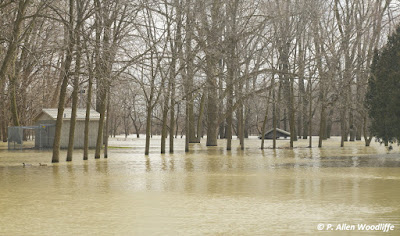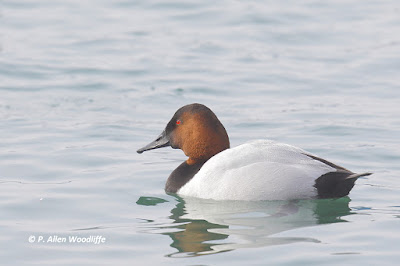There is no question that the last few days have had many people concerned in the Great Lakes Region. With the warm weather and substantial amounts of rainfall quickly melting the snow pack, there is a lot of water on the landscape!
I've been up along the St. Clair River a couple of times recently, partly hoping to see the King Eider that had been hanging around the north end of Stag Island for a few days. I didn't catch up to it, but saw lots of other waterfowl. The warm weather and rainfall has certainly cleared out a lot of the ice.
A Horned Grebe, hanging out in the vicinity of the Chenal Ecarte at the bridge that goes to Walpole Island First Nation was a bit of an early arrival.
Common Mergansers were quite common.
There was the occasional Hooded Merganser.
Long-tailed Ducks used to be a novelty on this river, but for the last decade or so, have become much more common. Several hundred, sometimes more, are scattered somewhere along the river on any given day.
Red-breasted Mergansers aren't as abundant as their Common relatives, but a few can be found.
Redheads are frequently seen, sometimes in large rafts.
Canvasback are reliably seen, although this year they haven't been nearly as common as Redhead.
I saw three Bald Eagles also, all immatures, but not well enough to try for a photo. A Great Blue Heron flushed up from a warm water outflow just south of Bickford Line. No photo there either.
While driving south along the river, I looked over at the edge of a woodlot which belongs to the family of a friend. I knew Wild Turkeys hung out there, as it is within my usual territory for the Christmas Bird Count. Sure enough there were a couple of dozen roaming around in the field just beyond the woods.
With all the rainfall, I knew that the McKeough Floodway would be in use. It was constructed in 1984 in response to the major flooding that Wallaceburg often experienced. The floodway re-directs excess water from the East and North Sydenham Rivers before it gets to Wallaceburg, thereby alleviating some of the flood risk. Sure enough, there was a lot of water flowing through the floodway and entering the St. Clair River safely away from Wallaceburg.
 |
| Floodway looking 'upstream' from Baseline Road |
After viewing the floodway I returned home via West Holt Road heading over to Hwy 40. I was pleased to see a Snowy Owl sitting cooperatively on top of a hydro pole, which allowed me to get some reasonable shots.
Upon arriving home on one of these occasions, before all the snow had disappeared, I was surprised to see Am Robins hanging out in our yard. At least a dozen were there, taking turns searching in the leaves near the base of the house which hadn't been covered with snow. They hung around for several days until most of the snow was gone, scattering to other snow-free areas.
Waterfowl were arriving in greater numbers in the vicinity of St. Clair NWA, as expected. I checked them out and saw many of the usual overwintering species, but caught up with Snow Geese and Greater White-fronted Geese as well, although they were too far away to bother with a photo. I did capture these Northern Pintail, however. The occasional one had been around all winter, as had Gadwall, Green-winged Teal and Am Wigeon, but there was definitely an influx of them in the last few days.
The flooded fields were very attractive to waterfowl.
They were much less attractive to the farming community. This part of Chatham-Kent is extremely flat, due to the outwash of receding glaciers a long time ago. This highly productive area dominated by rich black soil is a result of the wetland or prairie vegetation that developed here after the glaciers left. If the water levels of adjacent Lake St. Clair was high, it would be wetland; in periods of lower water level, it would be dominated by wet tallgrass prairie vegetation. But it has very poor natural drainage, so farmers do everything they can to remove standing water as quickly as possible. Pumping stations are strategically located, and in these last few days every one of them has been in operation where tractor powered pumps are going full tilt pumping the water off the fields, through the tile drains, and emptying the offending liquid into the larger drain system.

This particular photo was taken along Town Line Road and empties into Lake St. Clair at St. Luke's which is the north end of Town Line Road.
The Erieau area is always worth checking out due to the wetlands and waterfront there. Again, this time of year waterfowl are the most abundant bird species. It wasn't many days ago where the extensive ice conditions limited open water to these birds. The main channel often had a bit of open water.
A lone Gadwall was there, hanging out in the vicinity of Am Black Ducks.
 |
| A four-legged Mute Swan? |
On one of the warmer days I was there, the fog had rolled in making views much more challenging, so I opted for a different kind of photography.
I did see some waterfowl resting and feeding in the wet fields adjacent to McGeachy Pond just outside of Erieau. The fog wasn't quite as thick, but still made viewing and photography challenging. I got these three Greater White-fronted Geese under much less than ideal conditions.

On the way home I decided to check out the Indian/McGregor Creek diversion that protects the south end of Chatham from flooding. It is much smaller than the McKeough Floodway mentioned earlier, but the Indian/McGregor Creek watershed is much smaller than the combined East and North Sydenham Rivers. It wasn't that many decades ago when residents of south Chatham greatly feared the weather conditions we have been experiencing these last few days, as late winter and early spring flooding was almost a regular event. There hasn't been any serious flooding in that area since 1992 when this floodway project was completed. This first image shows McGregor Creek at the corner of Hwy 40 and Boundary Line, looking south. The creek at this point is normally less than 5 metres wide at the bottom with only a little water flowing. Here it is probably well over 100 metres wide.

This next photo shows McGregor Creek at the corner of Maynard Line and Creek Road. It clearly looks more like a small lake than a creek!
Flooding to some extent does still occur in the immediate area of downtown Chatham.
Here is an impressive aerial video of downtown Chatham taken today, Feb 24 just before peak water levels of the Thames River arrive. This video has now been taken down by the owner, unfortunately. But
this one shows another section of the river flood downstream from the downtown.























































